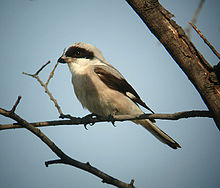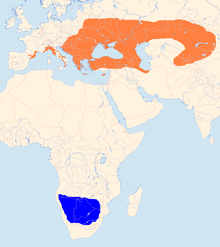Lesser grey shrike
| Lesser grey shrike | |
|---|---|
 |
|
| Scientific classification | |
| Kingdom: | Animalia |
| Phylum: | Chordata |
| Class: | Aves |
| Order: | Passeriformes |
| Family: | Laniidae |
| Genus: | Lanius |
| Species: | L. minor |
| Binomial name | |
|
Lanius minor Gmelin, 1788 |
|
 |
|
|
Summer Winter |
|
The lesser grey shrike (Lanius minor) is a member of the shrike family Laniidae. It breeds in South and Central Europe and western Asia in the summer and migrates to winter quarters in southern Africa in the early autumn, returning in spring. It is a scarce vagrant to western Europe, including Great Britain, usually as a spring or autumn erratic.
It is similar in appearance to the great grey shrike Lanius excubitor and the southern grey shrike Lanius meridionalis being predominantly black, white and grey, with the males having pink-flushed underparts. It is slightly smaller than the great grey shrike, and has a black forehead and relatively longer wings. This species prefers dry open lowlands, and is often seen on telephone wires.
This medium-sized passerine eats large insects, especially beetles, butterflies, moths and grasshoppers. Like other shrikes it hunts from prominent perches and sometimes impales corpses on thorns or barbed wire as a "larder".
The lesser grey shrike was first described by Johann Friedrich Gmelin in 1788. There are two subspecies, Lanius minor minor and Lanius minor turanicus.
The genus name, Lanius, is derived from the Latin word for "butcher", and some shrikes are also known as "butcher birds" because of their feeding habits. The specific minor is Latin for "smaller". The common English name "shrike" is from Old English scríc, "shriek", referring to the shrill call.
The adult male lesser grey shrike has its nape, cheeks, ear and eye coverts and front part of the crown black. The hind part of the crown and the back is a pale bluish-grey and the rump is a similar but rather paler colour. The underparts are white with the lower breast and belly suffused with pink. The axillaries are greyish-white and the underwing coverts are brownish-black. The two central tail feathers are black with a white tip and base. The other pairs have increasing areas of white and less black. The primaries are black with a buff tip and white base. The secondaries are black with broader, paler tips but no white bases. The wing coverts are black with the lesser coverts being fringed with grey. The female has similar plumage but the head is dark grey rather than black, the ear coverts brownish-black, the upperparts a brownish-grey and the underparts less pink than the male. The juvenile is similar to the adults but is altogether more brown. It lacks the grey back and rump which are instead pale brown and faintly barred, and the underparts are white and cream without any pink. All birds have a brownish-black beak with a paler base to the lower mandible, brown irises and black legs and feet. Adult length is around 20 cm (7.9 in) with a wing length of 13 cm (5.1 in) and a tarsus length of 2.5 cm (1 in).
...
Wikipedia

